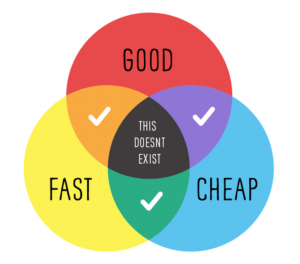The Rule of 2/3
The Rule of 2/3
There Are No Unicorns: Making the Hard Choice for Good/Fast/Cheap Marketing Support
You've heard of this rule before. It’s basically a law of physics in the business world: you've seen it applied to various industries of service providers, but that doesn't make it any less true. Marketing professionals know this rule all too well, but it can still be a stumbling block for our clients because it doesn’t seem fair and it’s not fun to think about. The hard truth is that the killer deals and 10-in-1 unicorn gadgets that exist in the retail product world just don’t exist in the realm of professional services.
The Rule: GOOD. FAST. CHEAP. You can only choose 2.
In short, it translates to this: you can’t have it all. If you don’t have a bottomless budget or all the time in the world, anyway, something else in the equation has to be sacrificed. While we would love to promise you that your great marketing strategy will pay for itself, we know that’s not exactly how budgets work. Instead of urging you to dig deeper into your pockets and put a strain on your business to put a top-tier marketing plan in place, we would much rather walk through the Sophie’s Choice situation with you and help you make the decision that’s best for your business right now.
The Options
CHEAP: You are always looking for a deal. It is our human condition to try to find ways to save money and retain the best value for the work we are paying for
FAST: You also want your projects done as quickly as possible.
GOOD: Not only do you want it done quickly and for less money, but you want it to be good. Good design, good strategy, good in every way.
Why can you only choose 2?
VALUE: The value of quality marketing work is not necessarily synonymous with the amount you pay. Value is provided when something is done well, with intention, and provides both instant results and long-term outcomes.
CHEAP + FAST: When you're choosing two, cheap and fast end up being a likely option. After all, those are your two primary motivational factors—get it done now and get it done for the least amount possible. The problem with this strategy is that it forces your marketing team into a situation in which they have to cut corners, spend less time finding the best possible solutions
and instead finish a “quick and dirty” version of your project. That means the thing you have sacrificed is GOOD. Your project will still have a lot of positive attributes, but will it be everything you hoped for, and be perfect without any missteps? Definitely not.
CHEAP + GOOD: In the above situation, it seems like the issue is one of time: by combining cheap and fast you lost quality, which is what you need in the long run. Choosing cheap and good could be a better combination because you save money while getting a higher quality completed project, which could ultimately mean higher value. The sacrifice here is time. In order to perform high-quality services at a lower rate, your team will need to manage this project differently. And you may be one of many projects in process, so in order to spend the time wisely on your project and make it beneficial to the team, they will need to take extra time.
FAST + GOOD: Yes, this is an option. Yes, we can do what you want in the quality that you want in the timeline you want, but that will mean our team will have to work double-time, triple-time, and that means itʼs going to cost you more because you will have to pay for that time and extra time spent.
Keep this in mind next time you are trying to hire a marketing company or any other service provider: you may have three options, but if you’re looking for real value, you will have to sacrifice one of them. Unicorns are hard to come by, and if it sounds too good to be true, it probably is.
Which 2 would you choose?
Need help deciding? Get in touch with us and let’s talk it out.
How to keep going when everything is f....unky
How to Keep Going When Everything is f....unky
Having trouble staying productive? The @revenue team has compiled some of our favorite tricks and tips to help you find ways to keep going and get everything done!
 Marie Hale, CEO
Marie Hale, CEO
Her #1 trick? “Plan and prioritize!”
The best advice she’s ever received or given? “Eat that frog! Do the hard stuff first! Block time on your calendar and hold it sacred. You deserve to work ON your business!”
Andrea Keirn, Marketing Integrator
Her #1 trick: “Make a list and get addicted to the checkmarks!”
The best advice she’s ever received or given? “ Listen with the intention of understanding, not the intention of responding- it helps you get better at accomplishing things more efficiently and more completely the first time”
 Joshua Lally, Special Ops
Joshua Lally, Special Ops
His #1 trick? “Put away the phone and other distractions”
Best advice he’s received or given? “Following the philosophy of "done, not perfect." Get it across the finish line, then work on beautification and perfection, but don't risk being late because you're stuck on details.”
Michelle Kidd, Executive Assistant
Her #1 trick? “ The most important thing is to take breaks. If you burn yourself out early in the day, you won't be as productive overall. Take 30 minutes to get away from your desk and watch an episode of a tv show, have a snack, go outside, or whatever you can do to rest your mind and spirit.”
The best advice she’s ever received or given? “Start with the thing you really don't want to do. If you get it out of the way, then it's done and it won't be looming over you anymore.”
 Carolina Franca, Graphic Designer
Carolina Franca, Graphic Designer
Her #1 trick? “setting the right mood to power up concentration. For example, music usually puts me on the productivity track.”
Best advice she’s ever received or given? “It's better done than perfect", because sometimes I may be a perfectionist, but when time is ticking, it's required to prioritize what is fundamental to get the job done and set aside what isn't.”

Rotimi Kehinde, Artistic Director
His #1 trick? “ 30min Tasks 5-Min Breaks Using the Pomodoro Technique”
The best advice he’s received or given? “You are who you are today because of what you put into yesterday.”

Kelsey Hoff, Copywriter
Her #1 trick? “For writing, I set a timer for an hour and I have to concentrate on my project until the hour is up--many times the hour will fly by and I will keep going after it's up.”
The best advice she’s received or given? “Keep it BIC (butt-in-chair)”
Danny Bernardo, Social Media Manager
His #1 trick? “Starting each week by identifying my goals, not only professionally but artistically and personally as well. I then take those goals and allocate time throughout the week to make sure they get done.”
Best advice he’s received or given: “"You can only be accountable to yourself. Prioritize the things that absolutely must get done but take time for your own well being as well."
 Raihan Reza, Marketing Support Specialist
Raihan Reza, Marketing Support Specialist
His #1 trick? “ Stay focused, have a plan!”
The best advice he’s received or given? “ Be calm and continue doing it.”
Need more inspiration to stay on track? We’ve got you covered. Here are our favorite tools and resources to help you stay organized, manage your time wisely and get it done!
Tools we Love:
- Franklin Covey Planner System
- Post it Notes/ Notebooks
- Pomodoro Apps
- Google/ Personal Calendar
- Dry Erase Board with color coded markers
Read & Watch:
- This TED talk on procrastination
- Big Rocks in First
- Eat That Frog!: 21 Great Ways to Stop Procrastinating and Get More Done in Less Time, by Bryan Tracy
- Outliers: The Story of Success, & The Tipping Point: How Little Things Can Make a Big Difference by Malcolm Gladwell
- Joy at Work: Organizing Your Professional Life by Marie Kondo and Scott Sonenshein
- The Success Principles, by Jack Canfield
Benefits of Hiring a Fractional CMO in 2020
Benefits of Hiring a Fractional CMO in 2020
In the unfolding economic crisis of 2020, most business leaders are pushing forward into new territory in one way or another, whether it’s internal restructuring or a complete overhaul of your offerings. Marketing is a high priority to not only survive these relentlessly uncertain times, but also to make sure the work you’re doing now is building towards a more sustainable future for your business. Many early-stage and small businesses are finding that they don’t have the marketing leadership in their C-suite to keep up.
There are plenty of ways companies end up in this situation: maybe you’ve gotten by without a CMO thus far, but other roles are too busy to manage marketing right now, or maybe things are changing fast in your industry and you need an expert with a wider range of experience. Maybe your company is growing faster than you anticipated and you need a marketing leader who can step in and chart the course until you can afford a full-time executive. An agency could do the trick, but you need a dedicated person “on the ground” with you who can strategize and implement with your team.
The short-term, big-commitment marketing leader you’re looking for does exist: meet the fractional CMO. This role is typically brought in to build up or manage your company’s marketing function on a part-time or short-term basis. From a cost-benefit standpoint, fractional CMO services deliver an incredible amount of value for much less than what an in-house team of their caliber would cost. The average salary for a full-time CMO is $174,573, and they usually have a marketing director or marketing manager working under them to carry out tactical work (earning average salaries of $87,915 and $65,399, respectively). And that’s before any benefits, payroll taxes or bonuses. All told, hiring a team with all of these roles plus support for digital and social implementation would cost over $400,000 per year in salaries alone. Working with @revenue for fractional CMO services costs about 30% less than that—around $280,000. See what we mean by fractional?
Take a look at some of the benefits a CMO offers that you won’t find with a consultant or a typical agency:
Evolves existing strategies and processes
When tried and true marketing channels aren’t working like they used to, it might seem like you have to abandon your entire strategy and start from scratch with a new approach—especially if you see your competitors finding success with new technology, social channels, etc. and you can’t keep up. Trusting an agency to make these calls for you can feel like a huge risk, and it is. If you don’t know where to start with new channels or how to make the transition without breaking the budget, a fractional CMO will take the time to get to know your existing strategy and make incremental changes to evolve it along with new tools and best practices so you can keep your momentum and your audience as your marketing processes change.
Crafts and manages a unified strategy with your team
Maybe you’ve tried some new marketing channels and been burned by one-stop solutions that didn’t do what they promised. Opening up new avenues for marketing takes an integrated strategy with someone experienced at the helm keeping a close eye on your metrics and making adjustments as you go. It takes a level of communication with your CEO and your team that most consultants and agencies don’t have the capacity for, but a fractional CMO is flexible to step in and actively manage your strategy in real-time.
High-level partnership
Speaking of communication, if you’ve made a big pivot recently and need to maintain consistency at a big-picture level, a fractional CMO often has the business leadership experience to take part in those C-suite conversations. Lots of companies are finding themselves in need of a high-level manager with the experience to build up a new marketing foundation while sales are lower than usual and they are still smoothing out the operations of a new business model. It can be a challenging time to hire the kind of full-time support you will eventually need, but a fractional CMO will fit the bill until the time is right.
Supports your sales team
Is your sales team struggling to work as a team while client responses are turbulent? Do they have any strategic marketing support, or are they creating their own materials? Often when there isn’t a robust marketing department, the onus falls on the sales team to generate, develop and close their own leads. Trying to get by without a dedicated marketing leader is a recipe for sales team burnout. A fractional CMO will find the gaps that are costing you sales and fill them so your salespeople can do what they do best.
A fractional CMO delivers the marketing leadership you need to keep growing your business while you need to keep cost, commitment and risk to a minimum. But the key factor that can really make or break this decision? The relationship you build with your fractional CMO is mission-critical. You have to find someone you trust, who will tell you the hard truths that will make for a better strategy in the end. At @revenue we call this Professional Love, and we insist on loving all of our clients, especially through their most difficult times.
But all good things must come to an end. Your team might absorb the new processes after the initial implementation, or the new revenue you generate might open up room for a full-time marketing executive. It takes about 6 months to see the full ROI from your CMO, but you may decide to work together for several years. Our team is great at documenting processes to hand back to your team whenever you’re ready.
Are you as excited as we are about the benefits of a fractional CMO? Get in touch with us and let’s talk about it!
5 Ways to Use Your Marketing Budget to Save Money
5 Ways to Use Your Marketing Budget to Save Money
The big question when it comes to marketing is always, “how much is this going to cost?” Generally speaking, marketing services are perceived as an expensive project and many business owners are hesitant to spend valuable dollars on something that may or may not have the return they hope for. At least, that’s one way to look at it.
The dollar amount you spend on a marketing project is only one small factor in that project’s performance. If you want to make your marketing budget work harder, it’s important to understand what the other factors are and how to make them work in your favor. It’s not just how much you spend, but how you spend it that makes the difference between just-okay and extraordinary results.
Unlike other business expenses, your marketing budget can have a direct and exponential effect on your bottom line if you manage it well. Finding the right marketing partner will also help you understand when and why to spend money on marketing. Use these tips to get to know your marketing budget a little better and uncover the best opportunities for your business:
#1 Separate Marketing and Advertising Line Items
Most business projections have a single category that accounts for both marketing and advertising. If you didn’t know this already, we have a secret for you: marketing and advertising are not the same things, and treating them the same way in your budget spells lower ROI for both. Simply put, advertising is the amount of money you need to pay to the media you place your campaign in while marketing is the planning, messaging, and design behind that campaign. You need both to make a splash, but they really should be viewed as two separate expenses.
#2 Compare Average Budgets
Taking a look at the benchmarks for similar-sized businesses is a good way to see if your marketing budget is on track to be competitive. For established businesses, The U.S. Small Business Administration recommends spending 7-8% of your gross revenue for businesses under $5 million, and closer to 10% for those over $5 million. New businesses should be spending somewhere between 12-20% of your revenue or expected revenue. This percentage of revenue should be split between marketing and advertising.
#3 Reserve a Marketing-Only Portion of Your Budget
The marketing-only piece of the budget should be around 5% of your expected gross revenue. This 5% should be allocated towards things such as the ongoing marketing implementation of a solid foundational strategy. These are the day-to-day tactics that engage your audience, the advertisements you place with specific media and tactics like email newsletters, video, content, and so forth. You should also expect to use more than 5% on big projects, such as website updates.
However, spending money on these day-to-day items will certainly be a waste of funds if you do not have a solid foundation.
#4 Build a Solid Foundation
To keep your sales pipeline moving and make the most of day-to-day activities with existing clients, you will need to invest in a solid marketing foundation. Since this generally includes the necessary larger projects, it will cost closer to 10% of your budget.
The foundation includes items like branding, strategy, website and social media. Working on these items to create a solid strategy that highlights your best target audience, the messaging and branding for those audiences and putting together a road map of strategy pieces paired with the big projects like a website will give you a healthy starting point. Once these things are completed, not only will your day-to-day activities will have a much higher conversion rate, but you will also have baseline KPIs to assess future campaigns.
#5 Consider the Cost of Client Acquisition
When making your marketing budget, the most important thing to remember is what your potential ROI will be. Consider what a single new client means to your bottom line. For example: imagine you have not built your foundation and you are relying on a salesperson to convert customers. You probably see the direct correlation between what you pay that salesperson
to what the conversion of each customer is. Letʼs say you currently spend $2,000 per new customer with your sales rep and he or she can convert 1 new customer per month. Provided that each new customer is worth more than the $2,000 you spent, you are happy.
But consider this: perhaps you built your foundation and were able to add a highly converting website and social media channels in addition to your sales rep. Using the 5% rule, letʼs say you spend $1,000 per month on digital media tactics and can convert 2 additional customers per month. You've increased your customers by three times while only spending a fraction of the cost and in a shorter time period.
Thatʼs where marketing becomes a saving vs. a spend. Looking at your current marketing budget is only the starting point for a strategy that should elevate your entire business. The key is finding a marketing partner who can work with you on the foundational items, but also on a long-term implementation and execution process. This is where you will save the most.
What are you looking for in a marketing partner? Let’s start a conversation and see if we’re a good fit.
How to Support Your Small Business Community During the Coronavirus Outbreak
How to Support Your Small Business Community During the Coronavirus Outbreak
It’s almost become a campaign cliche that small business is the backbone of America; but in the year 2020, amidst a viral outbreak like we’ve never seen before, the strength and flexibility of that “backbone” is being tested. Without much direction or aid coming from the government, we’re looking to each other to make a way forward—but there’s so much noise it’s hard to make some sense of it all. Our responsibilities as business owners have changed overnight and we’re asking ourselves where the money will come from, if and when we’ll have to let someone go, and how to go about making sales in a quarantined market.
Without a doubt, it’s an urgent time to support our networks while offering the opportunity to support us back. Nobody wants to come across as taking advantage of this awful situation, but what does one do if they want to appear authentic and actually help? Our team had a meeting of the minds this Monday; we came up with our best ideas to help you get through this time and come out on the other side with a team that believes in you, a customer base that knows that you care and partnerships that are even stronger.
Spend Wisely: Support Small
The #1 way to support your fellow business owners right now, as always, is to shop small. It’s especially important to think about brick and mortar businesses that usually rely on foot traffic, like restaurants and retailers. Many are scrambling to build online stores, but some have gift cards available on their existing websites. One of our favorite tricks for lunch meetings on lockdown is sending a GrubHub gift card with a list of locally-owned options.
Everyone’s budget is in flux, but necessaries like cleaning products can be found locally instead of at big-box stores. Think about any birthdays coming up and any other gifts you need to buy soon. Spend some of your downtime searching these local business directories to find what you need right now:
- Bossy Chicago
- Women Belong
- LGBT Chamber of Commerce
- Chicagoland Chamber of Commerce
- Neighborhood Chambers of Commerce (PDF)
Communicate Mindfully
As we all huddle up to our laptops to stay in touch with the world, we live and do business through our online presence, and our messaging becomes more critical than ever. Be sure to communicate with each of your audiences—yes, everyone—clients, partners, employees, the public, about any changes that will affect their business with you. Communicate with your existing network first before reaching out to new contacts. Post important information in a central location, like on your website, and use appropriate channels to share it.
Just as important as spreading the word about the changes in your business is putting other news on hold until you know for sure that it’s still moving forward according to plan. And even if it is, think twice about whether or not a big announcement is still appropriate. Blaring good news while so much is being canceled may come across as tone-deaf. News about product launches and events may need to be softened or postponed.
Manage Your Fear and Be a Leader
Fear of the unknown is a whopper, especially when you have a team (or a small community) looking to you for answers. While it’s an important time to show resilience, being honest about the things you still haven’t figured out is a much better look than withholding information.
If we didn’t know it before, it’s becoming abundantly clear that a business isn’t run by technology and systems: it’s run by a group of people with a shared goal. And when your mission is bigger than any single person on the team, you can have real faith that it’s all worthwhile. We at @revenue seek out other mission-driven businesses to work with because we believe this so much. Remind your team and your clients how important they are to you, and that no matter what else changes, your mission will drive you forward because it’s bigger than all of you.
Take Action
While you’re waiting on your bigger answers, take action on the things you have the power to do right now. If you need to get out of the house, My Block My Hood My City is accepting donations and organizing volunteers to distribute viral response packages to seniors. Reach out to your network and ask what kinds of support they are looking for.
One thing we know for sure is that this isn’t going to be over quickly; businesses that don’t already have a tech stack to support working from home will need to pull one together. Our team is working on a webinar to help you get digital quick, so watch out for more details! As always, let us know what else we can do to help.
You might need to hire a marketing agency if…
You Might Need to Hire a Marketing Agency If...
Let’s face it-- not every business needs a marketing agency. I know, it may seem counter-intuitive because every business needs a marketing strategy, but not everyone needs to go out and hire a professional to do the work. Whether you are just starting out or have decades of experience, marketing professionals aren’t free and when investing your time and finances you need to be sure that your business is ready.
That being said, there comes a point that professional support is what will take your business to the next level. Here are just a couple of signs that the time has come:
- If your parents don’t know what you do. You have no idea what your “brand” is and no idea how to talk about your business. You don’t need to be able to explain the intricacies of what you do, but you should be able to narrow it down to a couple of sentences. Marketing will help you to refine your message and give you crystal clear direction on how that gets expressed. Everything from colors and fonts to your voice and values needs to get expressed in a consistent manner that is easy for others to understand.
- If it gets pushed off your plate due to time or procrastination. You didn't open a business because you feel the joy of writing a good newsletter, or perhaps you avoid social media like the plague. Writing blogs, posting on social media and making website updates not only take valuable time but to do well it takes years of experience. Calculate your hourly rate by the number of hours you spend on marketing activities and see if you have some wiggle room to hire someone else to do it. Chances are when you leave it to an expert it will be done better than if you keep trying to do it yourself, and you may even save yourself some money & time along the way.
- You're ready for more business, but you don’t know how to ‘make’ it happen. If you've ever been asked "where do you get business from?" and your only answer is referrals, you are not in control of your sales... Let’s face it, hope isn’t the most effective strategy. If you are looking for more business, your marketing team should lay out a clear path to success and a pro will be able to recommend the right channels, strategies, and tools to get you there.
Agencies are great at providing the tools, resources, strategy, and implementation of marketing, but if you don't know your market, this is all a guess. Marketers work best when you know your business, and they help you communicate it. So go out there, talk to your customers, find out what they want more of and get clear on where your business is going. Then find a marketing firm that knows how to listen and provide great insight - they go hand in hand.
Although marketing might seem like the next step to growth, let’s not leave out it’s best friend: SALES! These two disciplines work hand in hand to drive more revenue. If you are out of balance, you will waste time and resources going down the wrong path. Schedule a complimentary consultation with our team @revenue to learn the best direction for your organization.
Personal Branding: 4 Rules to help you Rule
Personal Branding: 4 Rules to Help You Rule
Personal branding - the term is everywhere in the marketing world and experts and owners alike are diving headlong into creating a magical personal brand of their very own. As part of a larger strategy, personal brands can be a powerful way to establish expertise and connect with new audiences, but on it’s own a personal brand is not a revenue generator. Turns out, people don’t want to give you cash for just being they you-iest of yous! And at the @revenue office, the motto is: if it doesn’t help generate revenue, then it’s not for you.
One of the biggest questions you should be asking before you embark on creating a personal brand is: Do I know EXACTLY what I am going to be selling to the leads generated from this? If the answer feels ambiguous take a step back and map out what your offering will be. Even if the answer is products or services from within your current business, what it will take to fulfill them, and where you can create economies of scale to help you make more money in less time? (you get bonus points if it has a Monthly Recurring Revenue stream built into it). Know what success looks like before you start so you have a direction to go, because no matter how many likes, follows or watches you get, you are not going to be happy about the investment you make if it never pays you back.
As an expert, crafting and rolling out a personal brand will give you certain flexibilities that should happen outside of your business brand. Using your personal brand to reach out and create more one on one conversations, put you on stages, and increase your social media reach are all great goals to have. What then becomes important is how you will expect it to turn into income. Typically we will want to see a sales model with a personal brand that includes the following things:
- Paid speaking engagements
- Direct leads for your business
- Digital courses or materials like books, podcasts, etc.
- Advertising dollars for your YouTube Videos and podcasts
- Partnerships that will boost your business
Personal brands also take a long time to take root - this is no quick win. And what’s worse, is that a back-fire in your personal brand will follow YOU around, not the name on the company. So…. how can a personal brand backfire? Oh, let’s share some stories, shall we?
1. It’s not you.
Personal brands are all about authenticity. If your goal in crafting a personal brand to make people think things about you that aren’t true. This is where those idiosyncracies will come crawling into the daylight. Allow me to present Exhibit A: the photoshop fail.
This sounds contradictory at first, but your personal brand should include your thoughts on other things besides yourself. If every image you post, a comment you make or video you produce is part of a conversation then make sure you are talking to and about the world around you. You will exhaust your audience if every image is a hyper-filtered shot at exposing how fabulous your every moment is.
3. That’s right. You tweeted it and it was dumb.
We don’t have to reach too far into our consciousness to pull out a news story or two about an ill-timed tweet or tone-deaf message. And thanks to that cool little screen grab gadget it can live forever! If you are combining your personal brand with your private life brand be sure that you know that what you say will reflect on you and could possibly damage your business.
 4. Repping Products
4. Repping Products
If you do have a personal brand that lends itself to promoting products, you must ask the question, are they aligned with MY brand? I shudder at the term ‘influencer’ because of how much it’s been abused, but the things you recommend will become part of your reputation. As an expert in your field, you do not need to hashtag every cute cupcake unless your personal brand aligns with supporting that business or eating cupcakes like it is your job. Which it may be - and if that is your real job please call us immediately, we want in.
 Building a personal brand should be purposeful, strategic and hopefully a lot of fun.
Building a personal brand should be purposeful, strategic and hopefully a lot of fun.
If you want to learn more about building your own brand and how @revenue can help you integrate it into your marketing strategy let’s have that chat. marie@revenue.wp10.staging-site.io
The Click to Purchase Myth.
The Click to Purchase Myth
When small brands roll out big dreams.
There are billions of marketing books, articles and gurus all claiming they have a silver bullet to generate leads while you sleep and get you that beach house in a matter of months. Like most things, what you read will rarely transform your life. Why is that? One word: execution. So, after a couple of attempts on your own, you hire a marketing agency, armed with the knowledge by experts and prepared to make an investment that will generate high returns.
This may seem like an exaggeration, but in reality, it isn’t too far from the truth. Businesses see the opportunity and desire a “click to purchase” product or service. This is where you build your digital marketing machine with paid ads to generate leads and a website to purchase. Sounds simple and the books will give you formula after formula to make it happen. And then they hit the wall- where are sales?
Assuming that marketing will be your sole driver for revenue is one of the biggest mistakes we see business owners make.
If you are ready to launch a product or a click to purchase service, here are a couple of things you should keep in mind and be prepared for. Consider this your reality check:
- If you want to build a digital empire be prepared to have deep pockets. It takes a lot of money to get enough traction and analytics to make a dent and even that first sale will take time and refinement. Know that you will learn lessons along the way, and they will be expensive.
- It will take time. Nothing worth having comes easily or instantaneously. It takes a lot of testing, refining and optimizing to get your targeting and message right. It takes at least 3 months to create baselines, understand the market and get a good feel for where you want to go. Even those digital marketing gurus had thousands of things that didn’t work out until they found their golden goose; even if that’s all they talk about. Know that it will take you time too.
If that sounds unappealing, know that there is another way to get your click to purchase solution launched. Take the uncertainty out of the equation and build a business that lasts, not just until the next Google algorithm change.
You are going to need to sell the first several solutions or products. Yes, it’s true. You will need to talk to people, understand what motivates them and how your digital solution solves their challenges. By skipping these early sales conversations you will need to invest much more time and money in marketing proving out different hypothesis. By having the conversations and connecting with these customers, you gain valuable insights and feedback that will help your business exponentially.
Let’s face it, a consultative sales process where you get to understand your customer, build a relationship and find solutions is at odds with a digital play. On the internet, you have to guess at what their challenges are,and feed them information, facts, proof that you are awesome. When you have a consultation you build connection and learn about your clients. This just can’t be done authentically digitally until you understand it in the real world.
What this boils down to is sales process. The more complex the offering, the more complex the sale. Make sure you aren’t just building a marketing machine, but a sales process that aligns with your values, your business, and your customers needs.
Depending on marketing to solely drive your revenue from the get-go is a risky business. We believe in creating sustainable programs that support elevate and grow businesses, not that ARE the business. If you would like to learn more about what a sales and marketing strategy looks like for you- it's time for us to talk! info@revenue.wp10.staging-site.io
The difference between a marketing plan and a sales plan
The Difference Between a Marketing Plan and a Sales Plan
Business plans often glaze over sales and marketing very quickly. They want to know what the overall revenue goals are sure but the HOW is grossly underrepresented. That’s the problem of setting targets, goals, and dreams without understanding what it will take to get there.
We often find that sales and marketing are still the wild west of strategic planning. They get some top-level attention to help define key principles such as your target audience or your core values, but rarely include any of the actionable items. So how do we blend the strategy and plan to achieve that ultimate goal: more revenue?
Before you make the goals, check to make sure that you are incorporating all of the below:
Your marketing plan should include:
- Your key messaging concepts: What are you going to say that will capture your audience’s attention? What problem do you solve, what are the motivating factors, why does your customer care Your marketing plan should clearly and concisely be able to articulate your core message.
- The channels you plan to use: Once you know what you are saying, where you will say it is the next step. Each platform, channel, and community might need a different message and a different way of expressing it.
- Your investments (financial, time and frequency): Marketing is going to cost you one way or another, even free channels on social media are becoming more of a pay to play platform. Your marketing plan needs to map out your commitment.
- Your goals and KPIs. For each channel: It is critical that your plan includes clear expectations so you can measure your ROI, make adjustments and improve.
Your sales plan should include:
- Prospecting: where are you going to find new prospects and leads? Where and how are you networking? How does your personal brand show up on social media?
- Strategic Partners: Who are your business friends who send you more business? Building and developing great strategic partnerships is not only good business sense, but great for your pipeline.
- Your process. Creating a sales strategy takes careful process mapping. How do leads go through your pipeline? What are the critical steps that need to be taken? How can this process be repeatable across your entire team? If sales are the first ambassador of your brand, it is critical that you have a brand congruous process.
- Your KPIs and goals. You need to track your activity just as much as your results. As a sales professional, you need to put in the calls, work, and effort into finding your leads and building the business. Once you are able to hone in on those key metrics you will be able to calculate how much you make every time you pick up the phone.
Building both your sales and marketing muscles is critical to developing more revenue for your business. To help achieve maximum impact, many businesses are hiring a CRO (Chief Revenue Officer) to ensure both of these departments are achieving their shared goal, reducing processes and investments that aren’t paying off and holding the team accountable to growth. If it’s time to see more revenue come in your business we are here to get you there! Contact @revenue today and let’s create a plan for your next milestone.
The Times They Are A-Changing: Managing Fear
The Times They Are A-Changing: Managing Fear
Do you feel something is changing? I do. It’s everywhere and I can’t quite name it yet. It feels deep and systemic, something much bigger than just me or you. Are you feeling it too?
During the past 2 months, I’ve been feeling this big change coming and I’ve been working on managing fear. It’s like an undercurrent to every conversation I’ve had. Usually, I can turn up my entrepreneurial mojo and crank out a ton of work and just blast full steam ahead with a singular goal, and I’ve been doing that for about 4 weeks solid now. I’ve done it a million times over the past 15 years — you know how exciting it is to think up a new plan and start the wheels in motion. It’s the part of my job that I love the most.
This time, something is different, and it’s not just me this time. I’ve been talking to foundations, our competition, partner agencies, B Corp CEOs, women in my network, clients, and really anyone I can get for 15 minutes. Everyone is saying the same thing: something feels different and we’re not sure what it is.
I’m not sure either. But here are a few things I do know and I’m hearing from everyone else:
1. There is a clear shift to bring more purpose and intention into our day.
We don’t separate work and life. It’s one big thing and it can be overwhelming. The things we do and say make us who we are, so when one of those pieces doesn’t jive with the rest, we face big problems like self-doubt, anxiety, and anger. When you’re in charge of things, like a business, this can become extremely messy. Finding the right people to talk to, whether a network or a paid advisor is the way through. Because the only way out is through.
I’m seeing more consultants and small advisory practices focusing on self-care, mindfulness, and bringing intention and meaning to clients’ lives. There has been a big focus on the rise of the entrepreneur and the startup, the leader who grinds all day and has a singular vision of success through disruption. Are we getting burned out? Are we spending all of our time working and forgetting about what binds us together as human beings? Or are just spending too much time on Instagram?
I hear a collective need for coming back to mission, purpose, intent, and meaning, especially in the business world. There’s a desire to work less and experience more.
2. We are getting used to working and living in a climate of uncertainty.
The uncertain political climate destroys my business. When we didn’t have a budget in Illinois for a few years, almost all of our work dried up with our biggest client. We know the same happened for a lot of our consultant friends and nonprofits lost funding and resources across the board.
This new political uncertainty that we are all witnessing every day is something else. It is changing our spending habits; we’re less likely to sign up for something for a longer term. We’re hoarding cash because we’re waiting for the other shoe to drop. We are hearing about a coming recession, and we’re all wondering what’s going to happen.
Most of my competitors are talking about this. Some of them are digging in, some are getting out, and some are changing. We’re wondering what’s going to happen to our business and a lot of us are making pivots in our service lines and pricing structures to get ahead of it. We’re taking bets.
What does this mean? It means we’re realizing that business, as usual, isn’t working as usual and it’s up to us to keep things moving and for the betterment of our communities. This climate of uncertainty is designed to separate us and keep us alone and scared. I think a lot of us are at the point where we recognize: “yes, those people in charge of policy and big business are bananas crazy, but I need to keep my enterprise going to support my staff and family, so I’m going to keep going and do what I need to do to do that.” We recognize we are part of a system and we’re better of joining forces than going it alone. So let those crazies be crazy and let’s stand for something more.
3. We are slowly getting over being afraid.
I don’t know about you, but I used to be afraid almost all the time up until maybe a few months ago when I got to a breaking point. I finally realized that all of this worrying about uncertainty and what I SHOULD be doing wasn’t making my life any better. In fact, it was killing me.
Thinking back to when I started my business in 2004, I did that because I was tired of selling people crap based on the fear of not being good enough, or having some “other” person take everything away, or the fear of not keeping up or missing out. I rebelled against that idea in marketing, but most of everyone else didn’t. And marketing embraced it. So part of the issue why we’re all feeling like we’re falling behind because we let the marketing get to us.
This fear and anxiety is created by marketers, either deliberately or accidentally. It’s why we love and hate Facebook and why we are addicted to knee-jerk spending on Amazon. It’s a quick fix to a bigger problem: we’re afraid. We’re buying things that fix it for a moment, but in the long term we’ll just end up deeper in debt and at the mercy of the 1%.
I’m seeing a new trend emerging: one of fearlessness. Slowly, I’m seeing more honest questions, more support networks, and more authentic marketing that’s about creating real conversations.
I’m not sure what will be the result of all this, but I do know there is a new way and an old way. The old way is based on exclusion, fear, and profit. The new way is based on collaboration, honesty, and impact.
This is where I’m really excited. I know that the methods of design thinking, when used deliberately and inclusively are perfect for getting at the heart of the matter. It’s not always easy, but the results are always honest and insightful. This has been our practice for a long time now — extending far beyond branding and web development — and I think we’re in the right place at the right time to help more people make real change.
For us, this is the path that’s unfolding: our practice is about uncovering truths, defining a path forward, and inspiring and including. It’s less about the things we produce and more about teaching the tools and practices that help make the world better.
I created this model for to you get a sense of where you are in this uncertain time. Is your org or business responding or reacting? Is it from fear or inspiration?
[button style="red" float="left" margin="" size="small" link="https://www.limeredstudio.com/download/6779/" target=""]Click here to download my FEAR or INSPIRATION, RESPOND or REACT Worksheet[/button]












